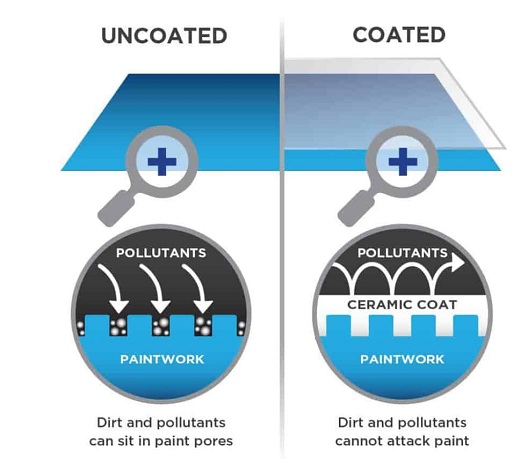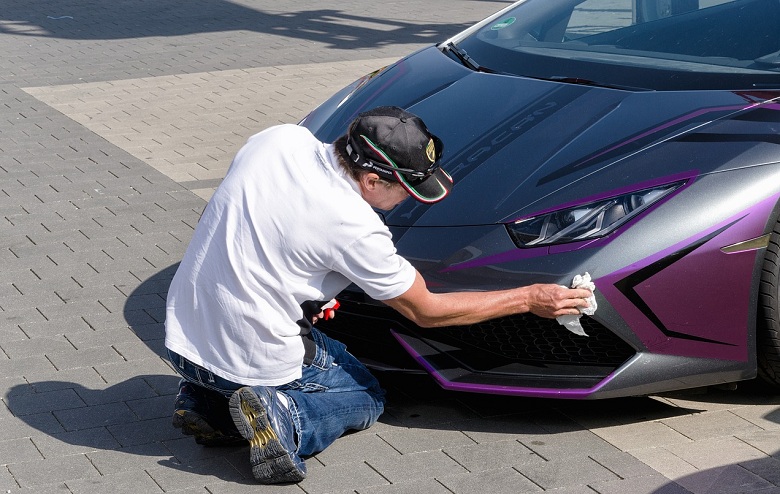Ceramic coating or nano coating is all the rage in the car world at the moment. It’s a fairly new product for car paint protection. No doubt you’re wondering exactly what it is, how to use it, and how it stacks up against waxes and other paint protection products.
If you’ve got questions about ceramic coating, you’ve come to the right place. Read on below for a run-down of how ceramic coating works, how to use it, and whether it’s the right choice for your vehicle.
What is ceramic coating?
Ceramic coating wasn’t designed to be a car protection product. In fact, it was designed for oil rigs and spaceships— heavy duty equipment that needs a lot of protection from the elements. Its effectiveness in these areas is what’s caught the attention of auto aficionados.
Ceramic coating takes advantage of nanotechnology. It may look like a liquid, but it’s actually composed of microscopic particles, invisible to the naked eye, suspended in a compound that allows them to adhere to other surfaces. This is what allows the coating to dry clear and invisible while still providing an exceptional level of protection.
Once these particles are in place, anything that touches your car touches them—not the paint. This can prevent a lot of the most common causes of paint damage, including scratches, fading, and oxidation. Other car treatments, like waxes, might promise similar protection, but none of them can come close to the effectiveness of ceramic coating. This graph shows the difference between ceramic coating and other treatments:
Source: detailingwiki.org
Though ceramic coatings have only recently attracted the attention of the average car owner, the truth is they’ve been used for years by high-end automotive detailers. In the past, these treatments were prohibitively expensive. The only people who used them tended to be owners of sports cars and other high-end vehicles.
This isn’t to say ceramic coating is cheap today, especially compared to other protection products like waxes. It has become more mainstream in the last few years, though. While some people still choose to have ceramic coating applied by a professional detailer, you can now buy kits in most auto repair stores that will allow you to apply the coating yourself at home.
Advantages of ceramic coating
- It’s hydrophobic. This means that any water that lands on your car will bead up and roll right off—taking most road dust and other dirt with it. It’s pretty impressive to watch, as you can see in the video below. This prevents rust as well as making your car easier to clean.
- It repels stains. The nano-particles are so small that the surface of your car is completely smooth at a microscopic level. Car paint feels smooth, but it has tiny pores where things can settle and adhere, eventually leading to staining and pitting. The coating fills in these pores, making it a lot harder for anything that lands on your car to stick.

Source: avalonking.com
- It prevents oxidation. Oxidation is another word for damage caused by air. In very simple terms, the molecules in your car’s paint react with oxygen molecules, altering them at a chemical level. The visible result is a dull, faded paint job with unsightly white patches. Ceramic coating prevents oxygen from coming into contact with the paint, avoiding oxidation.
- It prevents UV damage. Sun damage is another common cause of dull paint. Ceramic coating refracts the sun’s rays before they hit the paint. You can think of it like sunscreen for your car.
Disadvantages of ceramic coating
- It’s expensive. Even DIY ceramic coating kits cost in the neighborhood of $50-$150, depending on the brand. For professional application, the cost starts around $250 and goes up from there. This is twice as much or more as most waxes and other treatments.
- It won’t prevent serious scratches. Ceramic coating can protect your paint from minor scratches, but it won’t make your car impervious to damage. Some marketers advertise ceramic coatings as being resistant to rock chips and similar maladies, but these claims are largely exaggerated.
- It doesn’t last forever. Ceramic coating typically lasts 2-3 years. Again, this is longer than other treatments, but it does weaken over time like any other car protection technique.
- They aren’t designed to restore gloss or shine. The shine you’ll get from a fresh ceramic coating is on par with what you’d expect from a fresh wax job. It won’t restore color or shine to damaged paint, only prevent further damage.
How to apply ceramic coating at home: 6 easy steps
Any DIY ceramic coating you buy will come with its own detailed instructions. Make sure you read them through before you begin. The general process will follow the steps outlined below.
- Prepare your car by washing it thoroughly and drying it with a microfiber towel. If there are any swirl marks, paint scratches, or other imperfections you don’t want to be sealed in, fix those first before starting the application process.
- Park your car in a shaded place. A garage with the door open is ideal, but the most important thing is that it’s not out in the sun.
- Pour the ceramic coating on the application pad that comes with the DIY kit. These pads are designed to give you an optimal, smooth finish, so you don’t want to use a standard sponge or cloth. Apply it over the surface of your car in a criss-crossing motion.
- Wipe away remaining ceramic coating residue with a microfiber cloth.
- Use a second, clean microfiber cloth to buff the entire surface of the car.
- Allow the ceramic coating to dry. Each product will have its own recommended drying time, but it’s typically around 48 hours. You’ll want to leave your car parked in the shade while it dries, so make sure to do it over a weekend or holiday when you won’t need to use your car for a couple days.
So is ceramic coating worth it?
As you can see, applying ceramic coating to your vehicle is just as easy as applying any other wax or sealant. Since most other treatments need to be applied 1-2 times a year to be truly effective, it is a time saver in that regard.
Ceramic coating will certainly protect your car better than other products, too. It’s especially effective at preventing damage from oxidation and UV radiation. Cleaning your car will be much easier after the ceramic coating is applied, as well.
Now that you know what ceramic coating is—and what it can and can’t do—you can decide for yourself whether it’s a worthwhile investment for your vehicle. Applying it does require a bit of patience, but there’s no better way to prevent paint damage in the long-term.
